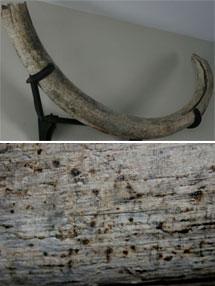
The 'bullet holes' in this tusk are found only on the skyward side.
Firestone et al.
Bullet-like pieces of what is thought to be an ancient meteorite shower have been found embedded in mammoth tusks and bison bone.
Posted on 12/12/2007 11:50:37 AM PST by neverdem
Fossils could provide a new gold mine for micrometeorite hunters.

The 'bullet holes' in this tusk are found only on the skyward side.
Firestone et al.
Bullet-like pieces of what is thought to be an ancient meteorite shower have been found embedded in mammoth tusks and bison bone.
The discovery of the 2–5 millimetre holes left by meteorites opens a window into a impact event thought to have happened over Alaska and Russia tens of thousands of years ago. And it could provide a whole new way to chart impacts from space.
The fragments, found in seven mammoth tusks and the skull and horns of a Siberian bison, match the geochemical composition of iron meteorites. "We think that the micrometeorites came from an air-burst of a meteor 30,000 to 34,000 years ago," says Richard Firestone, co-author of the study and a chemist at the Lawrence Berkeley National Laboratory in California. "We think a wave of meteoric material sprayed the region."
Some of the tusks are peppered with hundreds of the fragments, which had burnt grooves into the bone. All the pieces entered the bones on the skyward surfaces of the tusks and skull.
The researchers presented their findings on 11 December at the American Geophysical Union meeting in San Francisco.
Motel dream
Strangely, the trail to finding the tusks began at a fossil sale in a motel in Arizona.
Allen West, a self-taught geophysicist based in Arizona, was looking for evidence of a meteorite that he and his colleagues think caused the wipe-out of large mammals and the Clovis people in North America some 13,000 years ago. Recalling previous visits to the annual Tucson Gem and Mineral Show, West says, "A bulb went on in my head; I remembered seeing a room full of mammoth tusks there." He reasoned that tusks or antlers of deer or elk might have inadvertently captured exploding meteoritic material. So he went to a motel that shows the fossils, and sifted through the tusks.
"I spent two or three hours looking at dirty old tusks, when suddenly there was a burnt hole," he says. He tested it with a small magnet, as he knew many meteorites were mostly iron. "Bang; it stuck right to the hole," he says.
West bought the 60-centimetre tusk for about US$200, and later headed to the warehouse of the company that he bought it from: Canada Fossils.
After three days of searching through the company's collection of some 15,000 tusks, West started to find more evidence of micrometeorites in a batch from the Yukutia Peninsula in eastern Siberia. His magnet again repeatedly hit the mark on tell-tale burn holes.
West bought these tusks too and took them to Firestone and his colleagues for geochemical analysis and radiocarbon dating.
Past blast
The geochemical analysis confirmed that the pieces had a high iron and nickel content, and were low in titanium, making them more likely to be from meteorites than from Earth-bound rocks.
The dating showed that most of the tusks were 30,000 to 34,000 years old, and so not relevant to their theory about the end of the Clovis people (for more on that theory, see Blast in the past?). One tusk dated to 21,000 years ago, and the bison skull to 26,000 years old, but Firestone thinks that the dating of these specimens might have been affected by contamination of the samples. Future work, he thinks, will probably show them to be from the same meteorite shower as the other samples. They plan to refine the dates on all specimens as they move towards publication.
Firestone and his colleagues note that other scientists have found evidence that the populations of some large mammals — such as bison, horses and mammoths — declined about 34,000 years ago. That could go well with a theory of a meteor impact at that time.
The researchers hope that their find will spur others to look through fossils for signs of meteor impacts. “We’re hoping that museums and universities will start examining their collections for similar specimens,” says West.
no,they were all killed off by second hand smoke.
Cheney?
Wow. thanks for posting this.
Anybody got a unused helmet I can borrow?
And eating transfats.
Ping
fascinating story, amateur peanut gallery notwithstanding...
Still waiting for them to find viable sperm or ova in one of the frozen mammoths.
I’ve heard estimates that they figure there are still over 10,000 mammoths undiscovered in the permafrost.
Shooting from a UFO would cause that! :)
Now, were the mammoths alive at the time of the impacts or were they long frozen in the tundra?................
Global warming killed the mammoths.
Sounds like a story based upon location, location, location!!!
The caption below the pic states: "The 'bullet holes' in this tusk are found only on the skyward side." I have to conclude that it was standing upright. Although there could be other explanations, without more facts it's just speculation.
Did mammoths shed their tusks from time to time?..............
I can't say, but shedding doesn't make evolutionary sence. They spent a lot of energy to make the tusks, and they were very handy for combat and procreating. Elephants seem to keep them permanently.
Even if they did shed their tusks, wouldn't it be very odd that they remained sunny side up? With an offset center of gravity because of their curvature, wouldn't they be laying on the side?
Disclaimer: Opinions posted on Free Republic are those of the individual posters and do not necessarily represent the opinion of Free Republic or its management. All materials posted herein are protected by copyright law and the exemption for fair use of copyrighted works.